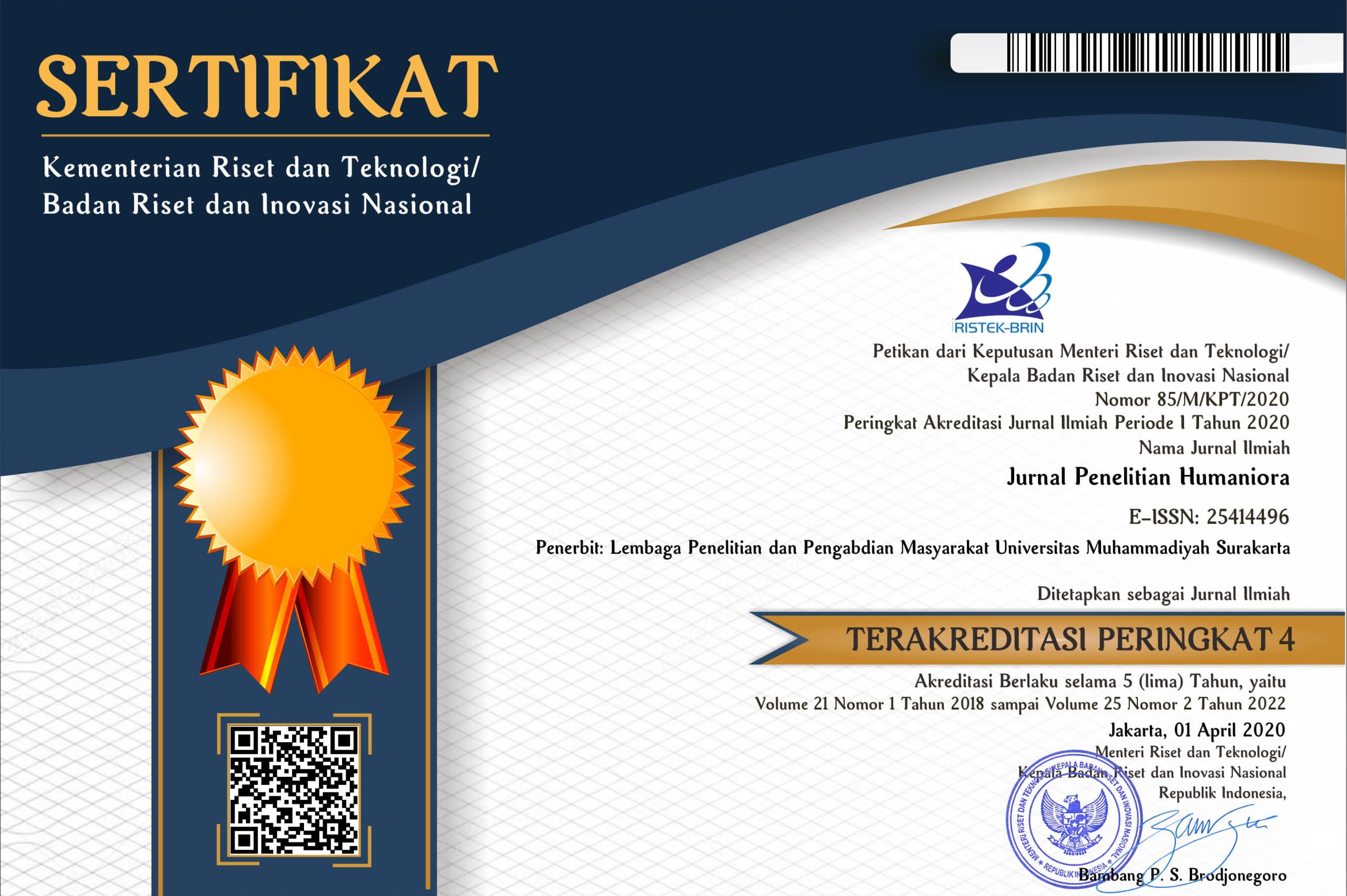MUATAN MORAL DALAM CERITA NAGASASRA DAN SABUK INTEN KARYA S.H. MINTARDJA
Tri Handito(1*), Kasiati Kasiati(2), Septi Septi(3)(1) Universitas Muhammadiyah Prof. Dr. Hamka
(2) Universitas Muhammadiyah Prof. Dr. Hamka
(3) Universitas Muhammadiyah Prof. Dr. Hamka
(*) Corresponding Author
Abstract
Keywords
Full Text:
PDFReferences
Abdulrani, S. (1996). Ikhtisar Sastra Indonesia. Bandung: Pustaka Setia.
Arikunto, S. (2013). Prosedur Penelitian Suatu Pendekatan Praktik. Jakarta: PT Rineka Cipta.
Atika, N. T., Wakhuyudin, H., & Fajriyah, K. (2019). Pelaksanaan penguatan pendidikan karak-ter membentuk karakter cinta tanah air. Mimbar Ilmu, 24(1), 105–113. https://doi.org/10.23887/mi.v24i1.17467
Hudaya, Z. A., & Nugroho, S. W. D. (2013). Kearifan lokal budaya Jawa sebagai basis model kepemimpinan yang efektif. Sustainable Competitive Advantage (SCA), 3(1). Retrieved from http://jp.feb.unsoed.ac.id/index.php/sca-1/article/view/222
Locke, E. A., & Latham, G. P. (2002). Building a practically useful theory of goal setting and task motivation. American Psychologist, A 35. https://doi.org/doi.org/10.1037/0003-066X.57.9.705
Mintardja, S. (1983). Nagasasra dan Sabuk Inten. Yoyakarta: Badan Penerbit Kedaulatan rakyat.
Moleong, L. J. (2014). Metodologi Penelitian Kualitatif Edisi Revisi. Bandung: PT Remaja Rosdakarya.
Prijanto, S. (2014). Makna Kejantanan dan Kesetiaan dalam Nagasasra dan Sabuk Inten Karya S. H. Mintardja. Jurnal Aksara, 26(2), 169–187.
Nurgiyantoro, B. (2000). Teori Pengkajian Fiksi. Yogyakarta: Gadjah Mada University Press.
Rengganis, R. (2017). Sastra Idealis Versus Industri Kreatif: Studi Kasus Film Nay sebagai Bentuk Filmisasi Novel Nayla Karya Djenar Mahesa Ayu. Jurnal Bahasa dan Sastra In-donesia Serta Pengajarannya, 3(1), 42–58. DOI?
Rosenbusch, K. (2013). Effective Leadership. European Journal of Training and Development, 37 No. 8. https://doi.org/doi.org/10.1108/EJTD-05-2013-0065
Runtu, B. W. (2003). Determinan kepemimpinan. Makara Human Behavior Studies in Asia, 7(2), 71. https://doi.org/10.7454/mssh.v7i2.57
Sayuti, S. A. (2000). Berkenalan dengan Prosa Fiksi. Yogyakarta: Gama Media.
Schaver, A. J. (2010). Effective leaders and leadership in policing: traits, assessment, develop-ment and expansion. Policing: An International Journal, 33( 4), 644-663. https://doi.org/doi.org/10.1108/13639511011085060
Shelley, M. (1984). Content-Analysis - An Introduction to Its Methodology - Krippendorff,K. Journal of the American Statistical Association, 79(385), 240. Retrieved from isi:A1984SJ28000060
Sigit, S. (1999). Pengantar Metodologi Penelitian Sosial, Bisnis, dan Manajemen. Yogyakarta: Lukman Offset.
Soenarjati dan Cholisin. (1989). Dasar dan Konsep Pendidikan Moral. Yogyakarta: Laboratori-um Jurusan PMP&KN FPIPS IKIP Yogyakarta.
Widodo, J. (2016). Konstruksi Pengetahuan Jawa dalam Novel Nagasasra dan Sabuk Inten Karya SH Mintardja. Universitas Negeri Malang.
Yasasusastra, J. S. (2011). Hasta Brata 8 Unsur Alam Simbol Kepemimpinan. Yogyakarta: Pustaka Mahardika.
Article Metrics
Abstract view(s): 504 time(s)PDF: 1103 time(s)
Refbacks
- There are currently no refbacks.











